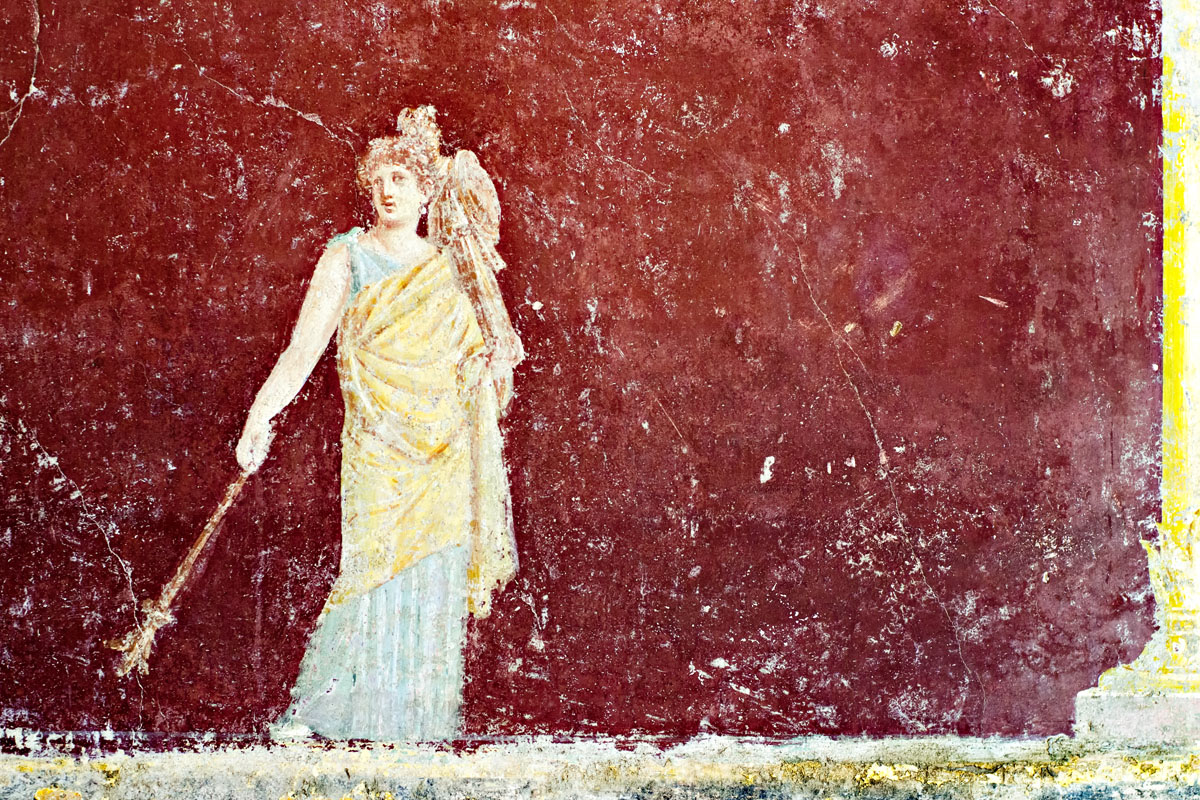Red
Terentia
Tullius
Julia
In Pompeji:
Purple was the ultimate symbol of power in the Roman Empire. In the first century . B.C., Pliny the Elder wrote: ‘it is this exquisite colour, which flirts with the spectrum of dark reds and pinks, that distinguishes a senator from a knight.’ An official’s rank was indicated by the width of the purple stripes on their garments. However, only the emperor himself was permitted to dress all in red. In late antiquity, draconian punishments were imposed for the unauthorised possession of purple (i.e. imperial) fabrics.


IN THE MODERN AGE:
Red has a unique effect on people and their behaviour. The allure of a woman dressed all in red is neither a coincidence nor a cliché. Red is a classic signal colour. It symbolises love and happiness, romance and passion; in China, it is also associated with wealth and prosperity.
IN THE HOME:
It’s all about the tone. When used as an accent colour, red sends a signal, makes a point and sets the stage for design highlights. When toned down using brown, red feels cosy, exudes warmth and promotes well-being within the room – like the comfort of the fireside. Colour psychologists recommend that red should chiefly be used as an accent colour. Rooms painted completely in red are a rarity. In a bedroom, for instance, it would be hard to get a good night’s sleep, as red is far too stimulating. A dark, vivid red by the fireplace, on the other hand, is invigorating and warm.

Red

In Pompeji:
Purple was the ultimate symbol of power in the Roman Empire. In the first century . B.C., Pliny the Elder wrote: ‘it is this exquisite colour, which flirts with the spectrum of dark reds and pinks, that distinguishes a senator from a knight.’ An official’s rank was indicated by the width of the purple stripes on their garments. However, only the emperor himself was permitted to dress all in red. In late antiquity, draconian punishments were imposed for the unauthorised possession of purple (i.e. imperial) fabrics.

IN THE MODERN AGE:
Red has a unique effect on people and their behaviour. The allure of a woman dressed all in red is neither a coincidence nor a cliché. Red is a classic signal colour. It symbolises love and happiness, romance and passion; in China, it is also associated with wealth and prosperity.

IN THE HOME:
It’s all about the tone. When used as an accent colour, red sends a signal, makes a point and sets the stage for design highlights. When toned down using brown, red feels cosy, exudes warmth and promotes well-being within the room – like the comfort of the fireside. Colour psychologists recommend that red should chiefly be used as an accent colour. Rooms painted completely in red are a rarity. In a bedroom, for instance, it would be hard to get a good night’s sleep, as red is far too stimulating. A dark, vivid red by the fireplace, on the other hand, is invigorating and warm.
Our shades of red
Terentia

Terentia:
It is claimed that Terentia, the wife of Cicero, lived to 103. She certainly outlived her husband by several decades. Terentia was extremely wealthy and used her fortune to preserve her independence and fund her son’s studies. By Roman standards, she was highly autonomous and was actively engaged in politics. She amassed her wealth through high rental incomes from country estates and town houses. This shade is vaguely reminiscent of the Roman bricks from which most of her properties were built.
Tullius:
Red has always been the colour of power. This unique red, however, has nothing arrogant about it, but rather radiates a natural power that will leave no one unmoved. Just like one of Cicero’s speeches. Marcus Tullius Cicero was a renowned senator, author, lawyer, orator and saviour of the republic. This shade is a homage to him.
Tullius

Julia

Julia:
The gens Julia was one of the oldest and most distinguished families in Rome – and produced many consuls. Its most famous son was none other than Julius Caesar. Amongst the family’s many famous daughters, the daughter of Augustus stands out. Julia was regarded as beautiful, intelligent and gentle, but also quick-witted with a sharp tongue. Whilst she was popular amongst the people on account of her friendly nature, she rebelled against her father so dramatically that he eventually banished her to an island, officially on account of her decadent lifestyle. What other colour could be more fitting for Julia than this particular shade of red?
Our shades of red
Terentia

Terentia:
It is claimed that Terentia, the wife of Cicero, lived to 103. She certainly outlived her husband by several decades. Terentia was extremely wealthy and used her fortune to preserve her independence and fund her son’s studies. By Roman standards, she was highly autonomous and was actively engaged in politics. She amassed her wealth through high rental incomes from country estates and town houses. This shade is vaguely reminiscent of the Roman bricks from which most of her properties were built.
Tullius

Tullius:
Red has always been the colour of power. This unique red, however, has nothing arrogant about it, but rather radiates a natural power that will leave no one unmoved. Just like one of Cicero’s speeches. Marcus Tullius Cicero was a renowned senator, author, lawyer, orator and saviour of the republic. This shade is a homage to him.
Julia

Julia:
The gens Julia was one of the oldest and most distinguished families in Rome – and produced many consuls. Its most famous son was none other than Julius Caesar. Amongst the family’s many famous daughters, the daughter of Augustus stands out. Julia was regarded as beautiful, intelligent and gentle, but also quick-witted with a sharp tongue. Whilst she was popular amongst the people on account of her friendly nature, she rebelled against her father so dramatically that he eventually banished her to an island, officially on account of her decadent lifestyle. What other colour could be more fitting for Julia than this particular shade of red?
Diedenhofener Straße 1
D-54294 Trier
bella-casa@mille-deco.com
Colours of Pompeii is a brand of premium wall paints. The range is inspired by the colours that one would once have seen on a stroll through Pompeii. Each colour is timeless and modern – and can be combined in a variety of ways.
